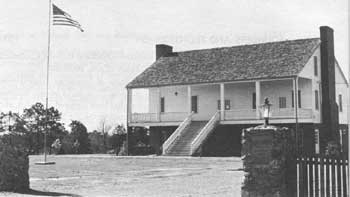





Survey of Historic Sites and Buildings
 |
FORT JESUP Louisiana |
|
| ||
Ownership and Administration. State of Louisiana.
Significance. From its founding, in 1822, until its inactivation, in 1845, this fort was the most southwesterly military outpost of the United States. Because of a dispute over the Texas-United States boundary, in 1806 Spain and the United States designated as a neutral strip an area 30 to 40 miles wide extending eastward from the Sabine River and embracing most of the present western tier of parishes in Louisiana. Under the Adams-Onis Treaty of 1819, the United States acquired this strip, which had become a haven for outlaws and marauders who molested settlers emigrating to Texas, and moved swiftly to occupy and police it. Pending ratification of the treaty, which occurred in 1821, the U.S. Government in 1820 built Fort Selden on the Bayou Pierre near its junction with the Red River just outside the strip on its eastern edge and the following year made plans to set up another post nearer the Sabine.
In 1822 the Army abandoned Fort Selden. Lt. Col. Zachary Taylor occupied the watershed between the Sabine and Red Rivers and moved to a point 25 miles south-southwest of Fort Selden, where his troops built a group of log cabins. Within a few months Cantonment Jesup, as the post was first called, was the largest garrison in Louisiana, consisting of four companies of the 7th Infantry under Lt. Col. James B. Many. In 1827-28 the troops helped construct a military road 262 miles northwest to Cantonment Towson, in Arkansas Territory; it linked the two most southwestern outposts of the U.S. Army. In 1831-33 Gen. Henry Leavenworth assumed command of the cantonment and garrisoned it with six companies of the 3d Infantry. In 1834 Colonel Many again assumed command. In 1833 the Government, recognizing the enlargement and expansion of the cantonment, redesignated it as the Post of Fort Jesup and created the 16,000-acre Fort Jesup Military Reservation.
After the Texas Revolution began, in 1835, reinforcements arrived at Fort Jesup. Maj. Gen. Edmund P. Gaines assembled 13 infantry companies at the fort and marched to the Sabine, where he founded a temporary post, Camp Sabine. From there he occupied Nacogdoches and remained until the independence of Texas was assured. In 1845, just after President Tyler ordered Gen. Zachary Taylor, commander of Fort Jesup, to move an army into Texas in anticipation of a war with Mexico, the Army inactivated the fort. It is a Registered National Historic Landmark relating primarily to political and military affairs, 1830-60.
 |
| Reconstructed officers' quarters, which now serve as a visitor center, at Fort Jesup State Monument, Louisiana. For nearly 25 years after its founding, in 1822, Fort Jesup was a key military post in the old Southwest. Courtesy, Louisiana State Parks and Recreation Commission. |
Present Appearance. In 1957 the State of Louisiana created Fort Jesup State Monument. It consists of about 22 acres. The only original building is one of the log kitchens, which has been repaired, reroofed, and refurnished with period reproductions and authentic kitchenware. An officers' quarters, reconstructed for use as a visitor center and park administrative office, contains exhibits that tell the story of the fort.
NHL Designation: 07/04/61
 |
 |
http://www.cr.nps.gov/history/online_books/founders-frontiersmen/sitec15.htm
Last Updated: 29-Aug-2005